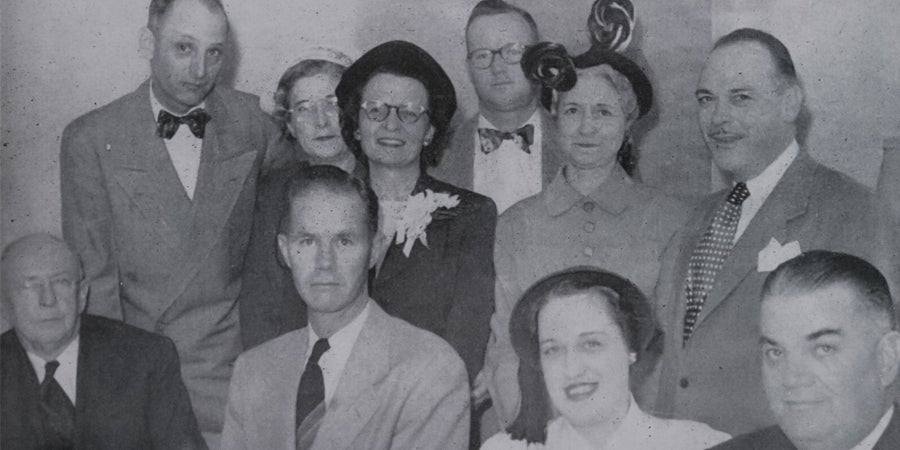TASB Board Has Guided Association Throughout Its History
At the heart of TASB’s governance structure is an understanding and appreciation of its members. Throughout its 75-year history, TASB has turned to members for leadership in developing and guiding its mission to provide advocacy, expert training, and high-quality services to school boards and districts.
TASB values the power of leveraging the expertise of members who not only lead their school districts but often are skilled professionals in business, law, technology, and other fields. They also represent the state’s geographic diversity, understanding their areas’ needs, challenges, and culture.
These trustees are devoted to running their school boards — and they bring that dedication, knowledge, experience, and understanding of public education to their leadership roles at TASB, helping it fulfill its many responsibilities to members.
“TASB is led by a trusted, experienced family of school board leaders who are bound by the common goal of fostering excellence in public education,” said current TASB President Armando Rodriguez, who also serves as Canutillo ISD’s board president. “Our Board leadership is dedicated to serving TASB and making sure it does all it can to help school boards and their districts provide the best education possible to students. I know I speak for the entire Board when I say we are honored, and humbled, to serve in this vital role.”
TASB is a member-led association, with six officers and a board of directors made up of trustees from districts in every education service center region in Texas, plus one representative for ESC boards. They help shape TASB’s future and ensure that the Association delivers practical, beneficial results to its members across Texas.
Board members are elected to the TASB Board at TASB’s Delegate Assembly, the annual membership meeting held at txEDCON. Delegate Assembly also adopts TASB’s Advocacy Agenda, which is created by members, for members. The Advocacy Agenda is a two-year action plan focusing on the legislative priorities of the more than 1,000 school boards in Texas. (Read more about TASB’s advocacy efforts, including Delegate Assembly, in the upcoming June issue of Texas Lone Star.)
“Our success over the past 75 years is really a reflection of our member-led governance structure that ensures TASB is aligning our work with member values, needs, and priorities,” said TASB Executive Director Dan Troxell.
In addition to the Board, other TASB affiliated entities also benefit from member leadership, including the TASB Risk Management Fund, Lone Star Investment Pool, The Local Government Purchasing Cooperative (also known as BuyBoard), TASB Benefits Cooperative, TASB Legal Assistance Fund, First Public Governance Committee, the National Purchasing Cooperative, and TASB Energy Cooperative. TASB entities have boards that include members who are trustees, superintendents, and other administrators. Throughout the year, these boards hold 29 official board meetings.
Early Days of Leadership
In November 1949, a small group of trustees gathered in Austin to charter TASB and elect its first leaders, including Ray K. Daily, a Houston school board member who was chosen as the first president, and Willie Kocurek of Austin ISD, selected as first vice president and then as TASB’s second president.
From the start, the trustees’ leadership was an acknowledged asset.
“Board members who belong to the Association also serve on a variety of committees, which are not only contributing to the improvement of education in Texas, but each board member who serves on one of these committees is a better board member after having served,” Kocurek, as TASB president, said at the Midwinter Conference on Education, held in Austin on Jan. 6, 1951. “It is through a continuing, growing, enthusiastic group of board members joined together in the Texas Association of School Boards that all of us in education can help to solve the major problems in Texas education.”
TASB continued its work to help school boards and expand membership. Some 20 years later, the 27-member board was expanded to 35 members representing 26 districts. Laura T. Doing, a Wichita Falls trustee and TASB president in 1970, solicited more representatives from urban boards.
In the late 1970s into 1989, TASB and its leadership helped members respond to challenges brought on by new laws and lawsuits and an emphasis on education reform. In January 1978, at a meeting of the TASB Board of Trustees, members decided to reevaluate TASB’s goals and objectives. They agreed that TASB was a threefold organization: service-oriented, management-oriented, and product-oriented. During the next decade, the Association would develop many services and programs based on those goals established by the Board.
At every major point in its history, TASB presidents and other board leaders have been at the forefront of helping the Association expertly and reliably serve its members in myriad ways. For example:
- Franklin Bass, then a Corpus Christi ISD trustee, served as president of TASB in 1978-79, a time when the Association was expanding its legislative goals, especially at the federal level. Bass also guided TASB in promoting more trustee involvement in Association activities. There was then record attendance at the annual convention, and the Spring Workshops and Board Leadership Workshops were highly successful.
- When Julianan Cowden, then an Alvarado ISD trustee, was president in 1982-83, TASB grew phenomenally, and the Texas School Services Foundation was developed to provide risk management programs.
- John Quisenberry, then an Ector County ISD trustee, became TASB president in 1984, when school districts were trying to implement the changes mandated by House Bill 72, a reform bill that impacted many aspects of district operations. Under Quisenberry’s leadership, TASB worked to help districts with the many changes they were facing. In addition, the Legislative Program developed under his leadership focused on changing some problem areas, such as class-size mandates, in HB 72.
TASB and its Board leadership have continuously worked to provide expert services and products to its members and understand members’ evolving needs. One of TASB’s goals has been to keep its annual membership fees as low as possible while also bringing an economy of scale to many district operations — helping reduce the burden of government. The same formula has been in place since 1978 to determine TASB membership fees with smaller districts paying less than larger ones. No district, however, no matter how large, pays more than $11,000 — a cap that has been in place since 1991.
TASB Board Today
Today, the Board convenes at least four times a year, but there is more work to be done in appointments to standing Board committees. Conference calls, informal meetings, events, and more activities are all part of a Board member’s work.
While this governance framework allows TASB to tap into trustees’ wealth of experience and knowledge, TASB directors also benefit from connecting with and learning from each other, becoming even stronger school leaders.
As part of the effort to honor TASB’s 75th anniversary this year, TASB staff interviewed several past presidents, asking them about the vital role the Board plays in TASB governance and some of the key initiatives they worked on during their tenures. Following are excerpts from those interviews.
Uniting Two Entities
Janis F. Petronis, a former Copperas Cove trustee, served as TASB president in 1987-88, a time when TASB and the Texas School Services Foundation began to combine some services. TSSF had been created in 1983 as a nonprofit to administer services in the risk management area.
“I think I served on the TASB Board as president at probably one of the most volatile times, not explosive volatile, but just change,” she said, noting there were basically two organizations, and the goal was to unite them.
“Through my presidency and the next couple after me, that was changed, and we brought all of the services under the TASB banner,” she said. “The Board believed it was important.”
She said the process began when she was president, but it continued under the two succeeding TASB presidents, Byron F. Black, TASB president 1988-89 and then a Burleson ISD trustee, and Charles Wade, TASB president 1989-90 and then a Monahans-Wickett-Pyote ISD trustee. “It wasn’t just during my term as president; it was two or three presidents there where we really changed the structure of TASB to pull it under one umbrella.”
Petronis also served as president when TASB worked on its strategic planning.
“During my term as president was when we did our first strategic plan for TASB, and it definitely was a game changer,” she said. “We as a team came together with where we were going and how we were going to get there, and it was just so exciting to me.”
Petronis said decisions had to be made on how TASB was going to divide things within the Association as well as how it was going to be run and what the goals and purposes would be.
“It was pioneering in that we were deciding our future. And the strategic planning effort, which is still very much a part of the organization today, started that effort. And if I could pick a singular thing, that would be it,” she said.
Working on Providing Resources
George H. McShan, a former Harlingen CISD trustee, was TASB’s first Black president, serving in 1998-99. “As the TASB president, it was a tremendous learning experience, an opportunity for me to lead in a way that was different. Because being the first Black president, and being from Harlingen, which is the southernmost part of the state, was a little bit different,” McShan said.
“At the time, TASB put emphasis on providing resources to school districts and what we did was we worked on entrepreneurships,” McShan said. “BuyBoard was one of the big things we started.”
The Local Government Purchasing Cooperative, also known as BuyBoard, launched in 1998. BuyBoard helps school districts and other local governments increase purchasing power, lower administrative costs, and streamline the procurement process. Membership in the Cooperative continues to grow and now numbers more than 3,000 governmental entities across the state.
McShan said the TASB Board was always focused on helping school districts — rural, urban, suburban — get the resources they need.
“You have to have resources to support districts,” he said.
“We are a nonprofit, so we felt we could do more. ... BuyBoard and the Lone Star Investment Pool were others. Districts had choices, and we gave them that choice. And we really focused on that and not just on memberships,” he said. “And if a district is investing in TASB, what are you going to get back? We stressed that, and it worked out very well.”
School Funding Challenges
Bret Begert is a longtime Fort Elliott CISD trustee who is now president of that board. Begert served on the TASB Board from 2005 to 2017 and was TASB president 2015-16, a period when the Texas Legislature enacted deep budget cuts to public education funding to overcome an overall shortfall in the state budget.
“The 2011 [legislative] session was not friendly to public education, and it was about that time when the districts faced so many cuts that the [TASB] staff and Board together waived the fees to our conferences to help our membership out and allow the training without cost, and it was very well received and appreciated from schools throughout the state,” Begert said.
Addressing Challenges
Jim Rice, a former Fort Bend ISD trustee, served on the TASB Board from 2012 to 2022. He served as board president in 2020-21, when James B. Crow retired as longtime TASB executive director. Rice’s term began in October 2020, months after the COVID-19 pandemic hit, forcing school districts to close.
The Board convened a search committee to find a replacement for Crow and had a recommendation to choose Troxell, who was unanimously approved, Rice said.
Navigating the ongoing pandemic was much more tumultuous. TASB, he said, had to pivot to work on canceling in-person events and shifting Summer Leadership Institute and txEDCON to online events.
“But TASB showed its resilience, really the TASB staff, stepped up to the plate and did that. And for the most part, we got through everything,” Rice said.
Selecting a New Brand
Recently, the TASB Board served an important role in guiding the Association’s brand and logo modernization effort.
While nonprofit organizations often outsource their rebranding campaigns to ad agencies, TASB once again turned to its Board for guidance. A key group of five TASB directors, the Planning and Development Subcommittee on Brand Modernization, worked hard on developing a new brand and logo recommendation.
“We appreciated having the opportunity to guide this project,” said TASB Immediate Past President and subcommittee member Debbie Gillespie, who served on the Frisco ISD board. “TASB staff were all so incredibly responsive to the committee’s concerns and questions as we worked through many possible designs and color combinations.”
Gillespie was joined by TASB First Vice-President Tony Hopkins, who serves on the Friendswood ISD board; TASB Director Sylvia Sánchez Garza of South Texas ISD; TASB Director Linda Gooch of Sunnyvale ISD; and former TASB Director Robert Westbrook, who until recently served on the Schertz-Cibolo-Universal City ISD board.
The subcommittee worked for several months on the project before presenting a recommendation to the entire TASB Board at the March 2023 meeting, where they approved the new logo and brand.
“Change can be difficult, but it’s also exciting,” Gillespie said.
The brand and logo project, along with other initiatives implemented during the past 75 years, demonstrate the vital importance of TASB Board leadership.
“Throughout our history, we have been blessed to have such extensive knowledge and dedication on our board,” Troxell said. “Our directors are always bringing that trusted experience to the table — and our members know they can depend on us to help them address any need or challenge.”
Laura Tolley
Laura Tolley is the managing editor of Texas Lone Star.
Sylvia Wood
Sylvia Wood is the division director of communications for TASB.





